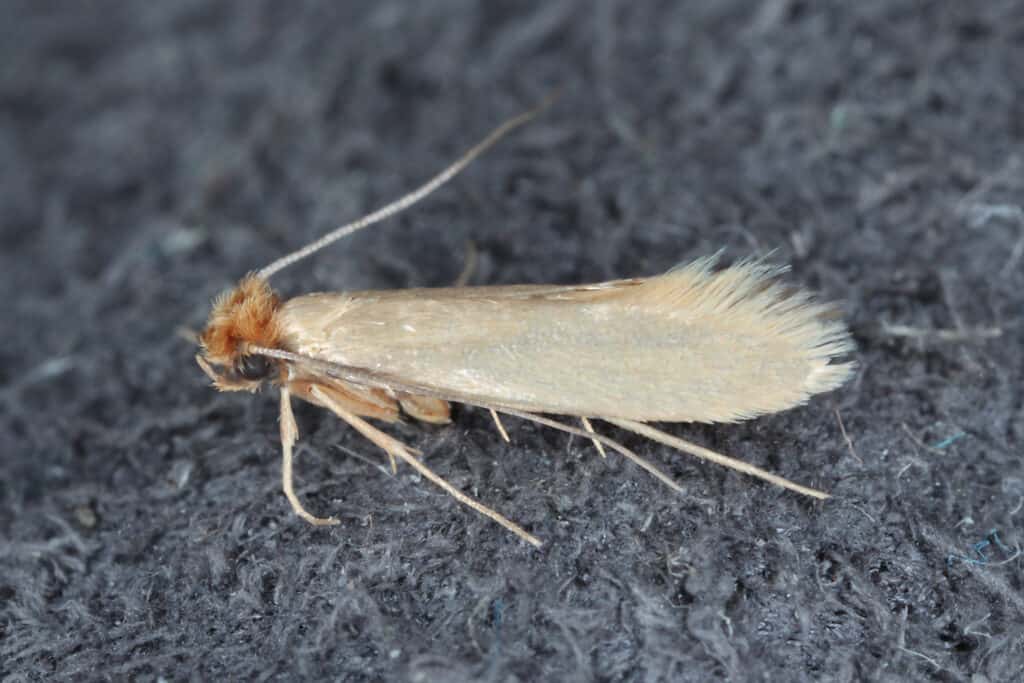Clothes Moth
Tineola bisselliella
Clothes Moths can remain in the larvae stage for up to 2 years, but adults only live 10 days.
Advertisement
Clothes Moth Scientific Classification
Clothes Moth Locations

Clothes Moth Facts
- Prey
- None
- Name Of Young
- Cartapillar
- Group Behavior
- Solitary
- Largely solitary
- Fun Fact
- Clothes Moths can remain in the larvae stage for up to 2 years, but adults only live 10 days.
- Other Name(s)
- Common Clothes Moths
- Wingspan
- 13mm
- Predators
- Birds, bats and lizards
- Diet
- Herbivore
- Favorite Food
- Organic fabric material
- Common Name
- Common clothes moth
- Nesting Location
- On clothes in dark places like closet or any other dark place
Clothes Moth Physical Characteristics
- Color
- Grey-Brown
- Golden
- Lifespan
- 30 days
- Weight
- N/a
- Height
- N/a
- Length
- 1/4 inches
- Age of Sexual Maturity
- N/a
- Venomous
- No
- Aggression
- Low
View all of the Clothes Moth images!
Clothes moths can remain in the larval stage for up to 2 years, but adults only live for 10 days.
Summary
The common clothes moth (Tineola bisselliella) is a fungus moth species belonging to the family Tineidae (fungus moths). The larvae (caterpillars) of this moth are serious household pests because they feed on and damage clothing items made of wool and other natural fibers. They may also damage upholstery, fur, and carpets. Adult clothes moths are weak flying insects that tend to hide when disturbed, making an infestation challenging to spot.
Clothes Moth Species, Types, and Scientific name
Tineola bisselliella (also known as the common clothes moth) is an insect that belongs to the family Tineidae (otherwise known as fungus moths). Tineid moths are insects in the order Lepidoptera along with other butterflies and moths. So far, more than 3,000 species of Tineid moths have been distributed into about 300 genera. We have only two species in the genus Tineola. These include Tineola bisselliella with a worldwide distribution and the Tineola anaphecola, native to DR Congo.
The common clothes moth is different from the case-bearing clothes moth, a species of Tineoid moths belonging to the same family but in a completely different genus (case-bearing clothes moths also destroy clothes, and they have a similar lifecycle and method of control). Common clothes moths are also called webbing clothes moths or clothing moths.
Appearance: How To Identify Clothes Moth
Clothes moths are small insects with golden or beige-colored wings. The fore and hind wings are characterized by fringe hairs along their margins. The wings have no patterns. They have a wingspan of about 9-16 mm (0.35–0.63 in), while the body length is typically about 6–7 mm (0.24–0.28 in).
The head of the clothes moth is typically coated with light ferruginous, reddish, or brownish-tinged hairs. It is whitish and typically has a brown head capsule with no eyes (ocelli). The ochreous coloring and red-orange hair on the insect’s head help to distinguish it from similar species. Their larvae typically reach lengths of about 13 mm.

Clothes mothes are typically beige colored.
©Thomas Kleidysz/Shutterstock.com
Habitat: Where to Find Clothes Moths
Although the clothes moth’s natural range used to be the western Palearctic, the moth is now found in many other parts of the world, including places that are outside its natural range. In areas where they’re found, they are indoor insects that inhabit clothing, carpets, and upholstery materials. They’re typically found in low-light conditions where they hide in dirty fabric, carpets, and rugs that provide all the nourishment and moisture they need for growth and sustenance.
Clothes moths prefer dark areas where they will not be disturbed, such as in closets, attics, or basements. Thus, if you spot any similar-looking moths in open, well-lighted areas like your kitchen, it is more likely to be a grain moth.
Diet: What Do Clothes Moths Eat?
Adult clothes moths don’t feed throughout their lifetime. They do not cause any damage to clothing. However, this moth’s larvae (caterpillars) are considered serious pests because they feed on clothing materials (especially wool) and other natural fabrics.
Adult clothes moths lay about 30 to 200 eggs about the size of a pinhead that attaches easily to the surface of the fabric substrate. The eggs hatch into the fabric-eating larvae between 4 to 10 days. They’ll remain in the larval stage for one month to two years, depending on the conditions of where they hatch. The creamy-white caterpillars are about ½ inch long when they hatch.
Clothes moth larvae prefer to feed within the folds and concealed areas of fabric materials. they can cause damage to clothes, upholstery, and carpets. They usually leave silken patches on the surface of the cloth and thread-bare spots in places where the fiber has been removed.
Prevention: How to Get Rid of Clothes Moth
The traditional approach for controlling clothes moths involves treating clothing with chemicals. Mothballs that emit toxic fumes are commonly used to kill clothes moth larvae and prevent infestation. However, these days, people now favor natural control methods such as using cedar oil, dried lavender, and other similar alternatives to avoid an infestation.
Clothes moths cannot survive high temperatures of up to 49°C or temperatures as low as -8°C f for more than 30 minutes. This can be used to kill all stages of the insects. Regular dry cleaning also helps to get rid of the moisture and dirt from the fabric, which is necessary for the larvae to thrive. A similar alternative is to store clothes in airtight bags where the insects will be unable to lay eggs or grow. People also use moth traps to attract and trap adult moths and to monitor infestation.
Suppose any of these cultural methods. In that case, you can spray it with insecticides like Pyrethrin, known to destroy the moths without leaving any residue on clothing like traditional chemicals.
Related Insects
View all 235 animals that start with CClothes Moth FAQs (Frequently Asked Questions)
Are Clothes Moth dangerous?
No, clothes moths are not dangerous. However, they can cause significant damage to clothing, upholstery, carpet, and other natural fibers in the home. Common natural fabrics they tend to damage include: wool, fur, feathers, and hides.
How do you know if you have clothes moths?
Cloth moths tend to hide in dark places like closets, making it difficult to detect infestations. However, you may notice signs of larvae infestation, such as irregular holes in your clothing. If you have fur garments, they may shed excessively due to the feeding action of the larva. In rare cases, you may see adult moths flying or crawling around on walls or items in your home.
How do you identify Clothes Moths?
Clothes moths are tiny moths with a beige or buff color. They are characterized by the red or brownish-colored hairs on their had, and they also have tiny hairs on the fringe of their narrow wings.
How long do clothes moths live?
Adult clothes moths live for about 15 to 30 days. Males usually die immediately after mating, while females die after laying eggs. The entire lifecycle from egg to adult lasts for 65-90 days and may be significantly longer depending on the condition where the eggs were laid.
Thank you for reading! Have some feedback for us? Contact the AZ Animals editorial team.
Sources
- National Pesticide Information Center / Accessed August 18, 2022
- Natural History Museum / Accessed August 18, 2022
- University of Kentucky / Accessed August 18, 2022
- Wikipedia / Accessed August 18, 2022

















